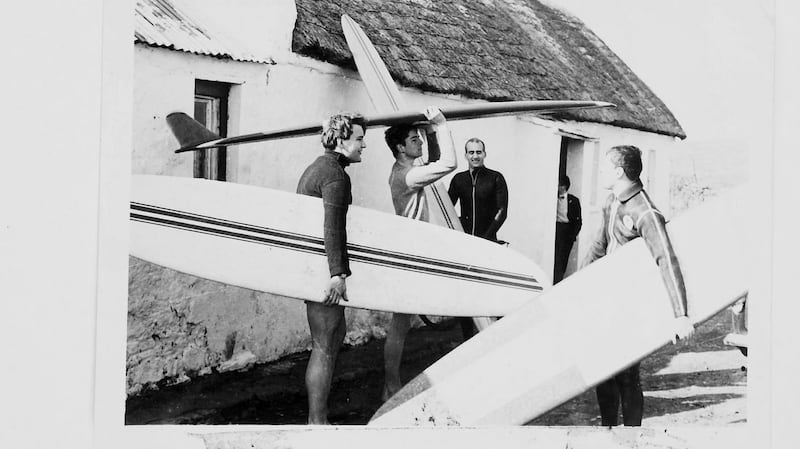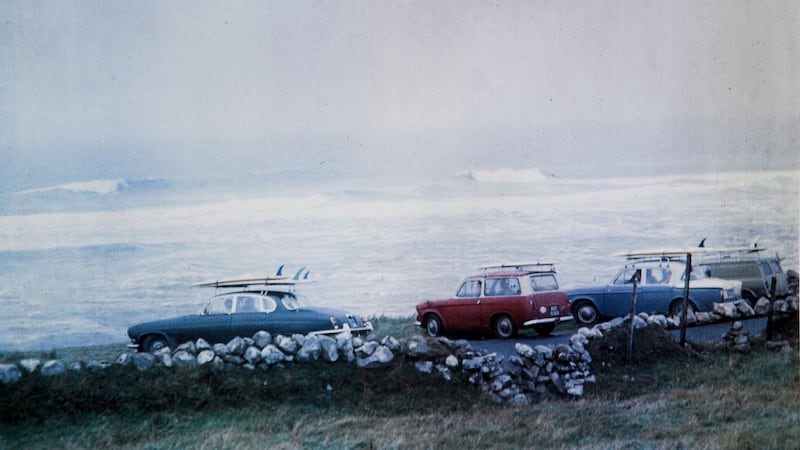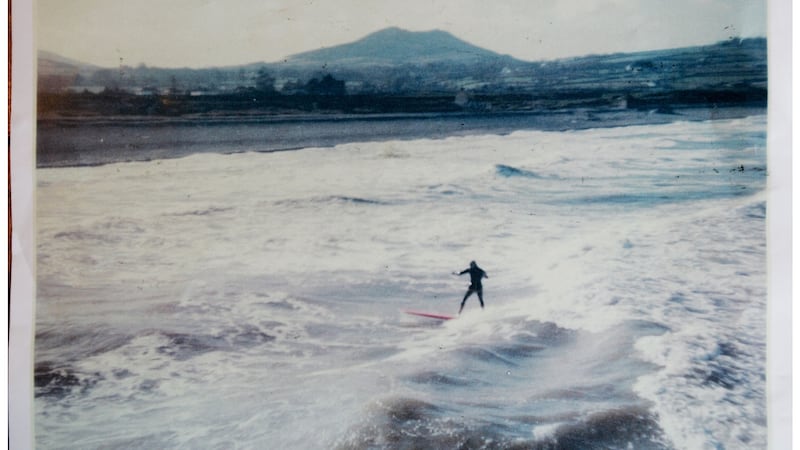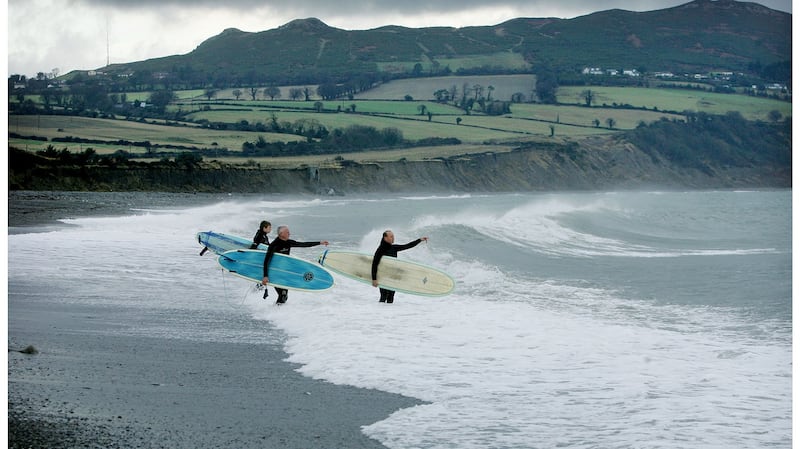Bray’s seafront may now abound with Lycra-clad fitness bunnies and avo-on-toast eateries but, despite its recent Californification, it is still hard to picture it as the birthplace of Irish surfing.
Rossnowlagh, Strandhill, Portrush and Tramore – these are the wind-swept beaches that spring to mind when you think about wave riding in Ireland, not a sheltered stony bay in Wicklow, best known for attracting day-trippers from Dublin.
Yet Kevin Cavey, whose family once ran the local Royal Starlight Hotel, can lay genuine claim to be the 'Godfather of Irish surfing'.
Obsessed with Hollywood in his youth, and particularly surfing after getting to visit California and Hawaii, Cavey founded Ireland's first club in the early 1960s.
When Roger Steadman, an Englishman posted to Dublin to work for Unilever, spotted the 'Bray Surf Club' stand at the 1965 Boat Show in the RDS, kindred spirits met and they soon encountered another in Harry Evans, whose teenage daughter Vivienne was one of the few females involved initially.
Soon Cavey and Steadman were off on their evangelising surf safaris around the island, setting up ‘C&S Surfboard Distributors’ to import the country’s first fibreglass boards and loaning samples to any like-minded souls they encountered.

Tramore was their first point of call, which is how people like Hugh O'Brien-Moran, the Musgraves and Eamon Matthews got hooked.
“Kevin left a board here for a week and when he came back it hadn’t hit dry land. We were all out surfing it, one after the other,” recalls local legend O’Brien-Moran.
Damian Musgrave still has one of those original Bilbo boards, stamped with C&S’s shamrock logo, and his brother Derek recalls that “when Kevin came to Tramore it was like Elvis arrived”.
Aspects of Irish surfing have been captured on film before but ‘Keep It A Secret’, a new documentary by Irish-American Seán Duggan, captures all the complexity and duality of its birth.
Duggan (50), whose grandparents emigrated from Sligo in the 1920s, grew up in New Jersey and now lives in Brooklyn. He has ridden the crowded breaks of Rockaway Beach for the past 30 years but his deep connection to the sea began during his first family trip back to Strandhill when he was just seven.
Even at that age he was spellbound by the splendour and isolation of Ireland’s west coast which he has surfed regularly since his late teens.

Duggan works in the business end of radio and digital media but admits to “always being fascinated by an origin story” so four years ago, when he heard there was a 50-year reunion in Tramore to mark it hosting the first Irish Surfing Championships in 1967, he flew in to capture as many of those involved as possible.
The ‘southern’ trailblazers also pointed him towards the notable absentees, specifically the northern pioneers who played a much more counter-culture but equally important role.
The founding fathers of the North's so-called 'black wetsuit brigade' were Belfast's Davy Govan, Martin Lloyd and Bo Vance. The latter pair ran Lloyd's Sound Studio – which made the first recordings of a teenage Van Morrison with Them – while some of Govan's youth was spent in Los Angeles thanks to his father's teaching job.
He returned, age 14, obsessed and his dad made him a plywood board he likens to “an aircraft carrier”.
Another Ulster crusader was Portrush's Alan Duke, a talented rider and board shaper, who recalls how, to construct their first primitive home-made wetsuits, "someone lay on the floor and we drew around them in felt-tip pen".
Donegal's Willie Britton remembers early local reactions with a chuckle. "It was an age of exploration and no one knew what we were doing. There was an old guy up the road who said 'there's somebody down there walkin' on the water! Were you doin' some wave-sliding?' They just didn't know what surfing was"

Govan still reckons the reef in Bundoran is one of the world's best and also favours the right-hand break in Easkey, even though he lost two front teeth there while surfing it in the dark.
Ulster’s burgeoning surf scene coincided with the start of the Troubles and provided its trailblazers with rare moments of joy and respite while a sectarian war raged around them.
“If they could have stopped the waves they would have,” Govan says of the forces that impinged their free spirits, describing surfing, without any irony, as his own “religious experience”.
For Duggan the intersection of such contrasting worlds in that embryonic period added an unexpected layer to his story and understanding.
“Over the years I’d been to Ireland so many times and mostly right by the Border, but it was never discussed why we didn’t go North,” he muses. “I feel I understand a lot more now of what the dynamics of the Troubles were, particularly how the civil rights movement in the States at that time was a catalyst for Catholic protest.”
His film illuminates another key difference between the two strands of Ireland’s surf pilgrims who became split over a philosophical difference that still divides the sport globally.

Southern surfers, mostly, led a crusade. They wanted to popularise and publicise the sport by creating an official governing body and competitive structure.
Many of those up North were diametrically opposed. Surfing’s ephemeral and esoteric elements enhanced their obsession. They also felt publicity would attract outsiders to over-populate their gloriously unspoiled aquatic turf, an attitude captured by the movie’s title.
The Brittons from Rossnowlagh – a seminal Irish surfing family – had four brothers (Barry, Willie, Brian and Conor) divided equally on either side of the debate who fell out for a time over this ethical difference.
Brian went on to become vice-president of World Surfing and tragically died in 2012, from cancer, less than six months after contributing to this film which also covers Ireland's unlikely hosting of the 1972 European Surfing Championships in Lahinch.
It was the bloodiest year in the North's conflict, with almost 500 lives lost, and, in the wake of Bloody Sunday, Ireland's Five Nations home games were cancelled. This unprecedented event left an international sporting vacuum, with concomitant sponsorship and media potential, which the nascent Irish Surfing Association – set up in 1970 – eagerly filled.
But it backfired badly when pancake flat water forced the cancellation of the second day of competition that September, an anti-climax which RTÉ's Fred Cogley can be heard melodramatically describing as "a terrible stillness in the air".

A big swell in Spanish Point the next day, to which many of those departing for Shannon Airport quickly diverted, saved face and was, possibly, the genesis of Ireland's reputation as a world-class surf destination.
In those turbulent political times the ripples from the Troubles even affected Kevin Cavey directly. A tour bus that had visited the hotel in Bray was fire-bombed when it got to Kerry. There were no human casualties but such incidents decimated Irish tourism in the 1970s and caused his family to emigrate to Canada.
He has since returned and, at 80, still rides the waves and the rift between Irish surfing’s pioneers has long healed.
Veteran riders of different ethical persuasions happily provided Duggan with original footage and testimony and he financed his first film by raising $25,000 through crowd -funding.
Today Ireland’s best proponents are best friends who share the northwest swells daily.
Conor Maguire is a big wave soul rider while Gearoid McDaid aspires to be Ireland's first Olympic surfer. Science and social media mean they can chase waves, all over the planet, literally on a ping from their phones.
That same technology means most of Ireland’s finest breaks are no longer a secret but some habits die hard. Of all those Duggan interviewed, only one was willing to share some still hidden gems. That man was Kevin Cavey.
– 'Keep It A Secret' had its world premiere in the Belfast Film Festival last week. It premiered in America over the weekend in the DOC NY Film Festival in Manhattan.















